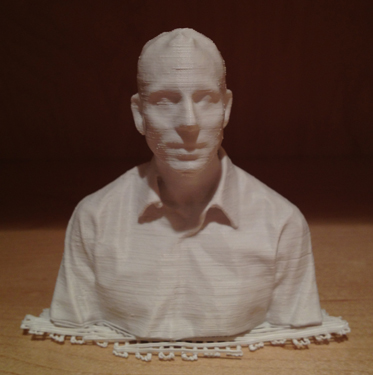Gartner: Get Ready for 3-D Printing in Your Face
The 3-D-printed bust at Jon Roskill's house is an example of the uneven distribution of the future.
Created last summer for the Microsoft Worldwide Partner Conference, the tiny likeness of Microsoft's channel chief was part of a presentation on near-future technologies. The session, designed to inspire the thousands of partners in the Toronto arena, included a camera/projector combination that allowed pen and paper sketches on one desk to be displayed on another and the 3-D printer that produced the mini-Roskill from a Kinect scan of his head and shoulders.
 |
| Image courtesy of Olivia Roskill. |
Because forms of 3-D printing emerged in the 1970s and most devices in subsequent decades were large and expensive with limited capabilities and lots of hype, it might not be apparent how close the technology is and how cheap it is getting.
That Microsoft could produce a demo in July 2012 didn't shed much more light on the price-performance progress, given the company's multibillion-dollar research budget.
A Gartner report this week, however, spotlights the rapid spread of the technology and the rapid fall in prices of 3-D, or additive, printers.
Gartner research director Pete Basiliere argues the technology is accelerating from niche to mainstream adoption in his report, "How 3D Printing Disrupts Business and Creates New Opportunities." The technology is already entrenched in automotive and other manufacturing, consumer goods, the military, medical equipment and the pharmaceutical industry, Gartner notes in a news release about its $195, six-page report.
Basiliere encourages enterprises of almost all types to buy 3-D printers now and start experimenting with personalized products, components, working prototypes and architectural models. The exercise is partly for immediate business benefit and partly to build a better institutional understanding of the technology and its possibilities. He says the printers are affordable now for any size business but predicts that what he calls "enterprise-class" 3-D printers will cost less than $2,000 by 2016.
As with drones and robots, a vibrant hobbyist community exists around 3-D printing. Looking at what hobbyists pay for do-it-yourself kits and fully assembled systems, it's easy to see that Gartner's price targets seem reasonable, maybe even a bit conservative.
Gartner's Basiliere points to the disruptive opportunities businesses could realize through 3-D printing, and highlights some positive social potential. He notes, for example, life-changing parts and products for struggling countries, ways to help rebuild crisis-hit areas and a democratization of manufacturing.
There's a darker side to 3-D printing, too. Individuals and organizations are already working on manufacturing printed firearms. Success would provide a way to pass metal detectors and to circumvent gun laws and international arms bans. Even without malice, sufficient progress on the speed and capability of 3-D printing might one day present a serious threat to the millions of jobs in transportation if local manufacturing through 3-D printing takes off.
For now, 3-D-printed objects like the Roskill bust are mostly scattered and widely separated. Soon they'll be everywhere. Time to get ready for 3-D printing in your face.
Posted by Scott Bekker on March 28, 2013